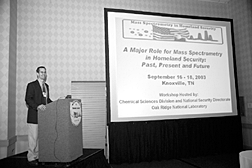 |
| Number 52, October 2003 |
 |
| Breaking new ground |
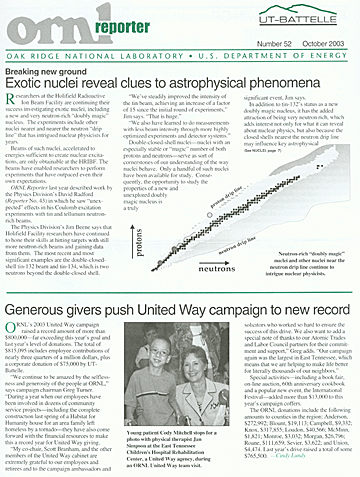 |
| Lab Notes |
|
|
|
|
|
|
|
|
|
|
|
|
|
|
Significant Event Awards recognize individual, team contributions to Lab |
|
|
Skills Enhancement Program: A partnership forged for success |
|
 Breaking new ground
Breaking new ground
Exotic nuclei reveal clues to astrophysical phenomena
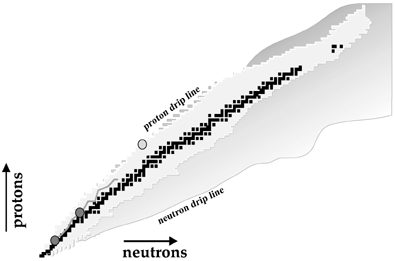 |
| Neutron-rich “doubly magic” nuclei and other nuclei near the neutron drip line continue to intrigue nuclear physicists. |
Researchers at the Holifield Radioactive Ion Beam Facility are continuing their success investigating exotic nuclei, including a new and very neutron-rich “doubly magic” nucleus. The experiments include other nuclei nearer and nearer the neutron “drip line” that has intrigued nuclear physicists for years.
Beams of such nuclei, accelerated to energies sufficient to create nuclear excitations, are only obtainable at the HRIBF. The beams have enabled researchers to perform experiments that have outpaced even their own expectations.
ORNL Reporter last year described work by the Physics Division’s David Radford (Reporter No. 43) in which he saw “unexpected” effects in his Coulomb excitation experiments with tin and tellurium neutron-rich beams.
The Physics Division’s Jim Beene says that Holifield Facility researchers have continued to hone their skills at hitting targets with still more neutron-rich beams and gaining data from them. The most recent and most significant examples are the double-closed-shell tin-132 beam and tin-134, which is two neutrons beyond the double-closed shell.
“We’ve steadily improved the intensity of the tin beam, achieving an increase of a factor of 15 since the initial round of experiments,” Jim says. “That is huge.”
“We also have learned to do measurements with less beam intensity through more highly optimized experiments and detector systems.”
Double-closed-shell nuclei—nuclei with an especially stable or “magic” number of both protons and neutrons—serve as sort of cornerstones of our understanding of the way nuclei behave. Only a handful of such nuclei have been available for study. Consequently, the opportunity to study the properties of a new and unexplored doubly magic nucleus is a truly significant event, Jim says.
In addition to tin-132’s status as a new doubly magic nucleus, it has the added attraction of being very neutron rich, which adds interest not only for what it can reveal about nuclear physics, but also because the closed shells nearest the neutron drip line may influence key astrophysical phenomena in important ways.
Jim explains: “The neutron drip line is reached when a nucleus has so many more neutrons than protons that the nucleus becomes unstable and neutrons ‘drip’ out. As you approach the drip line you encounter nuclei that are critical to the understanding of astrophysical phenomena, including the processes that account for much of the matter in our world. This region comprises the ‘R-process path.’
“The R-process is thought to occur in cataclysmic stellar explosions such as supernovae. During the explosion neutrons are captured by nuclei at a high rate and heavier elements are formed.”
Detailed exploration of this part of the nuclear map will have to wait for the next generation of radioactive ion beam facilities expected a decade or more from now, but for the time being the Holifield Facility is unique in its ability to turn over the first stones in this unexplored region.
“This R-process is believed to be how more than half of the elements heavier than iron are formed,” Jim says. “Closed shells and double-closed shells are waiting points in this process—regions in which nuclei are particularly stable—and neutron capture probabilities are low. These are the places where the Holifield can make a key contribution now.”
Jim notes the paradox: Although tin-132 is regarded as so highly unstable as to prevent researchers from studying it up until now, tin-132 is much more stable, with a 40-second half-life, than its neighbors, which have half lives less than a second in some cases.
“At HRIBF we want to study the structure of tin-132 because of what it can tell us about nuclear physics, as well as producing data relevant to astrophysics. Energies of first excited states in that region run at a constant 1 MeV, but at the double-closed shell, something dramatic happens: The energy jumps to 4 MeV,” Jim says.
This high-excitation energy means the experiments to study the first excited state in tin-132 have to be done quite differently because the probability of exciting the nuclear state is much smaller. Coupled with that challenge is a much lower beam intensity than for previously studied nuclei.
The group, including Robert Varner, built a very efficient gamma detector with an array of barium fluoride crystals, which are very fast, dense scintillators that represent a factor of 40 improvement in detecting 4 MeV gamma rays. They also used a different target—titanium—instead of the carbon David Radford used earlier.
The work has also benefited from researcher Dan Stracener’s discovery, outlined in Reporter 43, that the presence of sulfur enabled them to produce a beam of pure tin-132. Previously, tin-132 accounted for only one percent of the mass-132 isotopes in the original beam.
“Dan Stracener’s work is key,” Jim says. “The original discovery was serendipitous, but Dan realized its importance immediately and was able to optimize the idea and implement it very quickly as an operational technique.”
Although a goal was to measure tin-132, the group also measured germanium-82, which has a single-closed shell of neutrons, as a part of the dissertation research of graduate student Elizabeth Padilla.
Another point of interest on the nuclear map is tin-134, which has two extra neutrons outside the closed shell. These neutrons are known to interact strongly—neutron paring is a well-known phenomenon. Tin-134, Jim says, “is an important place to look, but it’s very tough because it is so neutron-rich it’s hard to produce, and once it’s made it lives only about one second.”
The Physics Division’s Witek Nazarewicz and collaborators theorized that under certain conditions this pairing weakens, and with the tin-134 measurement the Holifield team has been able to provide a critical test of the theory with an experiment that has stretched the bounds of the facility’s capabilities.
“With tin-132 we have 140,000 beam particles per second to work with, which is a tiny amount compared with more typical beams,” Jim says. “With tin-134 we had all of 3,000 beam particles per second to work with. It took all the efficiency we could muster. The setup designed for tin-132 only needed a little tweaking to make it work for 134. In spite of the difficulty, we were able to make a very accurate measurement. The experiment was a real tour de force; once the data analysis is complete there will be an interesting story to tell.
“We’re pushing farther from stability—with shorter-lived beams and less intensity,” he says. “People haven’t done this sort of stuff before, and we’ve had to learn as we go. Beam development is a critical aspect of these experiments, but we’ve also had to learn to work with big backgrounds, and less beam.—Bill Cabage
 Generous givers push United Way campaign to new record
Generous givers push United Way campaign to new record
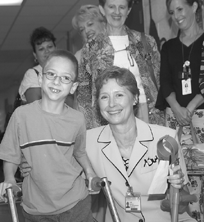 |
| Young patient Cody Mitchell stops for a photo with physical therapist Jan Simpson at the East Tennessee Children's Hospital Rehabilitation Center, a United Way agency, during an ORNL United Way team visit. |
ORNL will host the First Annual Hybrid Solar Lighting Summit in Knoxville, Tennessee, on October 7–8, 2003, at the National Transportation Research Center. Hybrid solar lighting is an innovative solar technology that uses sunlight in its natural form to reduce the need for electric lighting, the largest consumer of electricity in commercial buildings.
For more information on hybrid lighting or the conference go to www.ornl.gov/hybridlighting.
The Summit is intended for a broad audience of participants including energy and environmental policy makers, solar and clean energy advocates, lighting designers, architects, utilities, green power providers, and prospective commercialization partners.
 TeraGrid to link with OR neutron sciences facilities
TeraGrid to link with OR neutron sciences facilities
Researchers from around the nation will have access to some of the world’s finest scientific tools because of a $3.9 million grant from the National Science Foundation to the Center for Computational Sciences at ORNL.
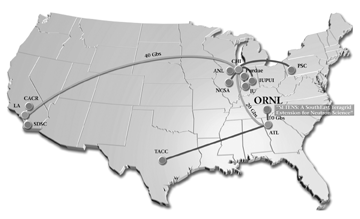 |
| The Teragrid Extension for Neutron Sciences will give researchers across the nation access to ORNL’s research tools. |
The grant is to establish a network hub and high-performance network connections to support access to ORNL’s neutron science instruments across the TeraGrid. The TeraGrid is part of a high-speed network that will provide scientists with extraordinary amounts of data from ORNL’s High Flux Isotope Reactor and the $1.4 billion Spallation Neutron Source. When complete, the TeraGrid’s network backbone will operate at 40 gigabits (40 billion bits) per second and will be the fastest research network in the world.
“This award is a wonderful illustration of the continuing partnership between NSF and the Department of Energy’s Office of Science on the TeraGrid,” says Raymond Orbach, director of the Office of Science. “ORNL’s Center for Computational Sciences will now be able to provide the nation’s research community with expanded access to ORNL’s extraordinary neutron science facilities.”
ORNL Director Jeff Wadsworth envisions the grant leading to increased utilization of the Lab’s unique and powerful research tools. “We are grateful to NSF for their grant to ORNL’s Center for Computational Sciences,” Wadsworth says. “Their partnership will support our efforts to broaden access to some of the fantastic new research facilities at the Laboratory.”
ORNL’s proposal was one of just three winners. Collaborators were the University of Tennessee, Georgia Institute of Technology, Duke University, Florida State University, North Carolina State University, Virginia Polytechnic Institute and the University of Virginia.
The ORNL-led addition to the TeraGrid, called the Southeastern TeraGrid Extension for Neutron Science, will allow scientists working at these facilities to use the massive computing and data storage resources on the TeraGrid to quickly make detailed analyses of data from neutron scattering experiments. And the system will provide near real-time feedback.
The TeraGrid is a cornerstone in NSF’s activities to develop a national cyberinfrastructure to revolutionize the conduct of science and engineering research and education. The ORNL award includes money to create a new TeraGrid hub in Atlanta, which will bring the number of TeraGrid hubs nationwide to three, joining existing hubs in Chicago and Los Angeles. The hubs are connected by high-speed optical links in multiples of 10 gigabits (10 billion bits per second). ORNL will connect to the Atlanta hub at 10 gigabits initially and will work with Georgia Tech to equip, operate and maintain the hub.
Others receiving NSF funding this year were Texas Advanced Computing Center at the University of Texas-Austin and a partnership of universities in Indiana led by Indiana and Purdue universities. —Ron Walli
 ORNL people
ORNL people
The Quasi-Poloidal Stellarator project, led by Jim Lyon and Brad Nelson of the Fusion Energy Division, passed a crucial milestone with the completion of a successful Conceptual Design Review. The QPS team is now preparing documentation for the next step in the DOE approval process, CD-1, which sets the cost range for the QPS project.
Lynn Boatner, a UT-Battelle corporate fellow and a researcher in the Condensed Matter Sciences Division, has earned the American Association for Crystal Growth Award—the highest honor presented by the association and given only once every three years. The award was given for his outstanding contributions to the field of crystal growth.
In a national competition, Vickie Conner in Creative Media won the American Graphic Design Award for her design of the new ORNL recruitment brochure.
Jerry Dean of Audit and Management Advisory Services recently passed the Certified Information Systems Auditor exam and is now a Certified Information Systems auditor.
 A nice time with mustard on it
A nice time with mustard on it |
| Jeff Smith (speaking) and Jeff Wadsworth (to the left) address the Main Street partygoers. |
The questions were: How do we offer staff members a chance to check out the new facilities in a way that gives everyone a chance to come, include an opportunity to recognize those who made the new labs and offices happen and, more importantly, make it fun?
The answers boiled down to hot dogs, several thousand of them, for September 12’s “Party on Main Street.” Organizers took advantage of the Research Office Building’s atrium area—called Main Street—and the courtyard outside, plus brand-new high-bay areas, for serving and seating in case of rain.
As it turned out, the weather was perfect, and hundreds of staff members enjoyed the just-completed courtyard area as musicians Jeff Barbra and Sarah Pirkle picked, fiddled and sang on the Main Street steps. Earlier, Lab Director Jeff Wadsworth and Deputy Director for Operations Jeff Smith recognized an assembled group of employees and construction contractors who worked to bring the project to fruition at a dazzling pace. Only 18 months earlier, the real estate was ORNL’s main parking lot.
The facilities are still getting the finishing touches. In fact, some of the grass in the courtyard was sodded down just the evening before.
Also present at the event were city of Oak Ridge employees involved in the project and Mayor David Bradshaw, who brought along the certificate of occupancy for the new space. The new, privately funded facilities will be joined by the state-funded Joint Institute for Computer Sciences and the federally funded Research Support Center to complete the new east campus.
 Lunch on the Buddy system
Lunch on the Buddy system
What’s that smell? It’s barbecue. ORNL’s new food service vendor, Buddy’s, began its tenure October 6. Buddy’s is the same well-known company that runs the region’s Buddy’s BBQ chain. The corporate food service arm of the firm, however, has a menu that runs well beyond barbecue. Buddy’s Cafe lunch entrees are aimed to suit the Lab’s diverse palate, including vegetarian and heart-healthy selections.
The new food service contract is the culmination of careful planning and negotiation as the Lab sought a for-profit vendor with experience in the food business. The process involved the Atomic Trades and Labor Council, whose members include long-time cafeteria workers.
“The ATLC is excited about the arrangement with Buddy’s and looks forward to working with them,” says ATLC Vice President Ed Mee.
Buddy’s Cafe Manager Rob Spires says regardless of the diverse menu, barbecue will indeed be offered throughout the week. A cooker has already been parked behind the ORNL cafeteria, and beef, pork and chicken dishes will be on the menu, with the sauce on the side. What about other dishes?
“I’m open to any and all suggestions. I’ll need feedback from our customers on what they want,” Rob says.
 Senator sees progress on our hill
Senator sees progress on our hill
“I can go back to the Senate and say that this is the very best way the taxpayers' money can be spent,” said Senate Majority Leader Bill Frist as he stood with Lab Director Jeff Wadsworth in the Spallation Neutron Source’s front-end building on Saturday, September 27.
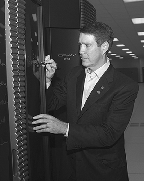 |
| Sen. Bill Frist signs his name to ORNL’s Cray X1 supercomputer. |
The senior senator from Tennessee had just returned with an entourage from a quick trip up to the overlook, just eluding a gullywashing thunderstorm by minutes. His only previous trip to the SNS had occurred on a much colder day, in December 1999, to attend the groundbreaking for the Office of Science-funded neutron scattering project. Three and a half years later and mid-way to the 2006 completion, the site has transformed from a forest tract to an airport-sized development.
“This project is coming alive all around us,” Frist said. Earlier he visited the Center for Computational Sciences in its new quarters on the east campus, where Frist lauded ORNL’s growth and what it means for the taxpayers and the economy.
“Five, 10, 15 years from now, these science investments will create hundreds of thousands, even millions, of jobs,” said the senator.
 A long walk in the woods
A long walk in the woods
For two nights spent in the woods, Slava Danilov packed pretty light. He would have packed more if he had actually intended to sleep out.
Slava, of the SNS Accelerator Systems Division, planned a day hike to some waterfalls off the Cherohala Skyway in the Cherokee National Forest near Tellico Plains. But a confusing matrix of trails and approaching darkness kept him in the woods the first night, September 24.
The second day Slava became more disoriented but managed to catch a signal on his cell phone to tell family and authorities he was okay. Searchers told him to stay put, but when they didn’t arrive, he realized he had wandered too far from where he left his car. He set out again, which led to his second night in the woods. By this time he was bloodied by briars and mindful of reports of coyotes in the area. “I slept with my knife in my hand,” Slava says.
The third day, Friday, September 26, he followed streams that eventually led to roads, where a fish hatchery employee picked him up, offered him a cigar and reported him found. Slava says the hatchery was 40 miles down the highway from where he left his car.
Slava was lucky: He had a jacket, a phone, water and nearly perfect weather for his trip. His luck wouldn’t have lasted if he had been caught in the storm system that arrived during Sen. Frist’s visit on September 27.
“If it were raining I would have been dead,” Slava says.
| —Reported by Bill Cabage |
 Significant Event Awards recognize individual, team contributions to Lab
Significant Event Awards recognize individual, team contributions to Lab
More than 170 ORNL staff members recently received Significant Event Awards in recognition of achievements during the second half of fiscal year 2003. SEAs — lump-sum monetary awards of various amounts —recognize individual employees and teams for their contributions and achievement of significant goals or milestones in support of Laboratory goals and objectives.
Nominations for these semiannual awards, which are presented in March and September, are reviewed and approved by their respective divisions and directorates before final selection by a Leadership Team subcommittee. Following are the most recent SEA recipients. Congratulations to them on their good work and contributions.
Annetta P. Watson, Dennis M. Opresko, Robert A. Young, Harold T. Borges, Lee A. Wilson, Marilyn E. Langston, Carol S. Wood, and Cheryl B. Bast of Life Sciences for chemical warfare agent toxicity guidelines developed by a Life Sciences Division Team that were judged scientifically valid by the National Research Council and published by the National Academy Press (May 2003).
Baohua Gu of Environmental Sciences and Gilbert M. Brown of Chemical Sciences for their development of selective ion exchange, novel resin regeneration and perchlorate destruction for treatment of contaminated groundwater and drinking water.
Denise K. Casey of Life Sciences for “Genome 101” education sessions at the Hart Senate Office Building and the Cannon House Office Building in Washington, D. C., on June 9 and 13, 2003.
Gail R. Hamilton of Environmental Sciences for her response to a sudden technical crisis that was pivotal in the successful completion of a complex project involving ORNL, industrial and NASA researchers, Laboratory guest services and the Lab Shift Superintendent.
Melinda D. Ingram, Susan G. Perkins, Connie L. Begovich, Bobby L. Lepard Jr., Beatrice G. Calloway and Marci W. Davidson of Business & Information Systems for their implementation of Travel Expense System (TravX).
Brenda S. Hembree of Communications & Community Outreach for savings associated with procuring printing services from the Government Printing Office.
James J. Kulesz of Computational Sciences & Engineering for initiation and realization of SensorNet Program.
George I. Fann, Ross J. Toedte, Stewart P. Dickson and James A. Kohl of Computer Science & Mathematics for construction of PowerWall in the Computational Sciences Building.
Kimberly A. Milburn of Business & Information Services for investigation and submittal of Exhibit 300 for Office of Management & Budget (OMB), Capital Planning and Investment Control.
John R. Drake, John S. Long, Brian K. Swail, Suzanne W. Willoughby, Susan E. Hicks, Charles D. Fisher and Rex E. Duncan of Networking & Computing Technologies; Anthony R. Medley and Ricky J. Forbes of Facilities Development; and Richard A. Alexander, Arthur S. Bland and Stanley R. White of Computer Science & Mathematics for planning and execution of the move of ORNL’s entire Computer Center and network backbone to the new Computational Sciences Building.
Danny H. Powell, Jose A. March-Leuba and Taner Uckan of Nuclear Science & Technology for successfully completing installation of the Blend Down Monitoring System at Zelenogorsk-HEU Transparency Program.
James F. Lyon, Bradley E. Nelson, Steven P. Hirshman, Donald A. Spong and Lee A. Berry of Fusion Energy for successful review of the Quasi-Poloidal Stellarator Conceptual Design Report.
Peter J. Chiaro Jr. of Engineering Science & Technology for development of a National and International Operational Testing and Evaluation Program.
Shaun S. Gleason, Michael J. Paulus, James S. Goddard Jr., and John C. Turner of Engineering Science & Technology for demonstration of Small Animal Motion-Corrected SPECT Imaging System.
John P. Stovall of Engineering Science & Technology for his efforts in the dedication of the National Transmission Technology Research Center.
Luther D. Lambert of Nuclear Science & Technology for establishment of Kola Technical Center, Oak Ridge’s leading role in Strategic Rocket Forces program.
Shean P. Huff, Brian H. West, William P. Partridge Jr., John M. Storey and Samuel A. Lewis Sr. of Engineering Science & Technology for confirmation of extensive fuel reforming and engine-out hydrogen generation for advanced NOx absorber control strategies.
Charles L. Britton Jr. of Engineering Science & Technology for his development of Halliburton: High Temperature Rail-to-Rail Operational Amplifier (op-amp).
Charles S. Daw and Charles E. Finney of Engineering Science & Technology for successful development and demonstration of the Flame Doctor system for monitoring combustion quality.
Jerald A. Atchley of Engineering Science & Technology for managing an unusually heavy and diverse laboratory test schedule and execution.
Alice F. Rice, Barbara J. Snow, Angela C. Alford and Nancy A. Hatmaker of Nuclear Science & Technology for their efforts through the Radiation Safety Information Computational Center in co-hosting the American Nuclear Society’s Mathematics and Computations Topical Meeting, April 6-10, 2003.
Mary L. Bible of Engineering Science & Technology for 100 percent completion ahead of schedule of ESTD’s annual FY 2003 property inventory.
Tracy H. Bryant of Engineering Science & Technology for financial planning and control system for the Fuels, Engines, Emissions Research Center.
Janet M. Miller of Engineering Science & Technology for her outstanding organizational skills, international communications, technical editing and administrative support in the organization of the IEEE/SME/SPIE 6th International Conference on Quality Control by Artificial Vision.
Teresa A. Childs, Rosa T. Murr, Robert A. Bryant, Donna H. Stringfield, Frances S. Drake, Michael A. Miller, Edith C. Jones, James K. Sellars and Sarah H. Shaver of Records, Training, & SBMS Services for development and on-time deployment of the Standards Based Management System at ORNL.
Michael I. Morris of Nuclear Science & Technology; Mary S. Condon, James L. Johnson and Albert L. Herrell of Environmental Protection & Waste Services; Roger C. O’Dell of Operational Safety Services; Sandra B. Kennedy of Physics; and Karen C. Bradley of Contracts for their efforts in the legacy materials disposition initiative for obsolete pumps and motors and gas cylinders.
Regis S. Loffman, Steven R. Lewis and Robert A. Anderson of Environmental Protection & Waste Services for their Environmental Protection Agency multi-media audit.
Richard E. Peden Jr. of Environmental Protection & Waste Services for his efforts in off-site shipment of newly generated hazardous waste for commercial treatment and disposal.
Timothy E. Myrick of Facilities & Operations; Richard C. Griffin, Gerald L. Palau and Peter R. Kulesza of Facilities Development; James W. Mathys of Facilities Management; John H. Watson Jr. of Laboratory Protection; Crystal A. Schrof of Legal; and David D. Skipper of Environmental Protection & Waste Services for their efforts in the east campus construction startup.
Curtis E. Moore of Craft Resources for implementation of the Facilities and Operations Safety Plan and STOP Program.
James C. Watson and Thomas R. Underwood of Nonreactor Nuclear Facilities and Peter G. Knox of Craft Resources for implementation of the NNFD Work Control Center.
Hans R. Vogel of Research Reactors; and Mark W. Kohring, David G. Renfro, John H. Platfoot and Michael A. Green of Operational Safety Services for submittal of 10 CFR 830 Subpart B, Compliant Documented Safety Analyses for nonreactor nuclear facilities.
Richard C. Griffin, Peter R. Kulesza, Deborah B. McCarter, Richard M. Collins, Bart A. Hammontree and Richard E. Haun Jr. of Facilities Development for east campus infrastructure interfaces with Facility Revitalization Projects.
Linda L. Gilpin of Nonreactor Nuclear Facilities and Gary Q. Kirk and Gregory E. Chitwood of Quality Services for NNFD implementation and assumption of responsibilities.
Carlo D. Melbihess of Facilities Development; Stephen D. Van Hoesen of Environmental Protection & Waste Services; John S. Bowman, Jack W. Schaefer Jr., Hurtis U. Hodges and Tammy J. Rader of Facilities Management; and Mitchell L. Conner of Operational Safety Services for their efforts in preparing buildings 9204-1 (Beta 1), 9610-2, 9999-3, 9999-4 and the 9204-1 scrap yard for transfer to other DOE program offices at the Y-12 National Security Complex.
Keith J. Dempsey and Vicky H. Wallace of Facilities Development; George H. Clark of Business & Information Services; Nicole E. Porter, Alan M. Parker and Claire W. Chitwood of Legal; Jon J. Bartlett of Asset Management & Small Business Programs and Dana C. Green of the Office of Laboratory Director for their efforts in east campus construction startup.
Craig A. Blue of Metals & Ceramics Division and Arthur Clemons of National Security Directorate for their accomplishments in advanced materials for the Yucca Mountain Project.
Michael R. Dinehart, Clifford T. LeCroy and Darryl T. Dowling of Physics for their efforts in the ORIC proton beam energy increase.
David B. Poker for providing the Condensed Matter Sciences Division with an effective operations program that incorporates Integrated Safety Management principles and the new work control process.
John E. Polinsky Sr. and Michael E. Buchanan of Research Reactors for repair of fission chamber assembly for High Flux Isotope Reactor
Dan Shapira and Paul E. Mueller of Physics for their measurement of the fusion of 132Sn with 64Ni at subbarrier energies.
Charles T. Ramsey of Research Reactors for preparation of 10 CFR 830—compliant safety basis documents for HFIR.
Paul W. Stankus of Physics for initiation of the hard-scattering physics program at the Relativistic Heavy Ion Collider.
Ralph B. Dinwiddie of Metals & Ceramics Division for developing a new tool for the study of the Lost-Foam-Casting Process.
David C. Harper, Brenda D. Hickman and Ronald H. Baldwin of Metals & Ceramics and Jewel L. Brown of Facilities Management for installation of power for a 0.75-megawatt plasma lamp in the high bay of Building 4508.
Mary L. Wells of Research Reactors for her efforts on HFIR Updated Safety Analysis Report – 2003.
Roxanne A. Raschke of Metals & Ceramics for development and implementation of two major workshops.
Richard R. Allen, Ronald E. Battle, Kenneth K. Chipley, J. Allen Crabtree, Phillip D. Ferguson, Franz X. Gallmeier, Robert R. Huerto, Erik B. Iverson, Lorelei L. Jacobs, David C. Lousteau, George Q. Rennich, Mark J. Rennich, David H. Vandergriff, Mark W. Wendel and Albert E. Williams of SNS Experimental Facilities Division; Irina I. Popov of Spallation Neutron Source; and David L. Conner of Nuclear Science & Technology for completion of the Title II Design Reviews for the target systems part of the Spallation Neutron Source.
Saeed Assadi, Danny S. Stout, Alexander V. Aleksandrov, Craig E. Deibele, Willem Blokland and Kerry G. Potter of SNS Accelerator Systems Division; and Warren P. Grice of Computer Science & Mathematics; for development, implementation and commissioning of a laser-based beam profile monitor system for the SNS accelerator.
Mary L. Howell, Karen L. Nolan, Rebecca A. Lawson, Karen S. Cox and Sara L. Trammel of the SNS Deputy Project Director’s Office for implementation of the electronic document management system for the SNS Project.
 Benefits open enrollment scheduled
Benefits open enrollment scheduled
The open enrollment period for benefits is being scheduled for November. Specific dates are being finalized and will be announced when set. For the first time, employees will be able to complete medical, dental and flexible spending account enrollments on-line through employee self-service (ESS), with no paper forms required.
Open enrollment presents the opportunity for employees to make several adjustments in benefits elections:
- Add or remove dependents
- Change level of coverage: family, dual or single
- Change premium deductions: pre- or post- tax
- Change health care plans
- Add or drop dental coverage.
Health care plans are changing for 2004. Some of the changes include:
- A new CIGNA open access plan to replace the current Option 1 plan for salaried employees
- Changes in co-pays and premiums
- Enhancements to the dental plan. Details are still being finalized and much more information will be coming in the weeks ahead. A benefits fair is planned for November 5 as a forum for employees to gain information about all the benefits available at ORNL.
An open enrollment Website will go up later this month with all the information about the plan changes to help in making informed choices about your benefit elections. A Q&A section will be featured on the Website. If you have a question you would like to see included, please submit it to ORNL Benefits at Benefits@ornl.gov.
 New Wigner Fellows include first couple
New Wigner Fellows include first couple
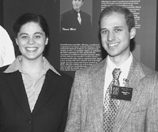 |
 |
| Victoria and Brian D’Urso | David Silvermyr |
Victoria D’Urso joins the Science and Technology Policy group in Environmental Sciences, Brian D’Urso joins the Advanced Lasers, Optics and Diagnostics Technology group in the Engineering Science and Technology Division. David Silvermyr joins the High Energy Reactions group in Physics. Since the program was established in1975, 65 fellowships have been awarded.
 2002 Benefit Plans Summary Annual Report
2002 Benefit Plans Summary Annual Report
Plan Participants and Beneficiaries:(The 2002 benefits plans report has been prepared in accordance with instruction from the U.S. Department of Labor and is required by the Employee Retirement Income Security Act of 1974.)
This report summarizes the annual reports of the benefit plans provided by the sponsoring employers, BWXT Y-12, L.L.C. (Employer Identification Number: 54-1987297) and UT-Battelle, L.L.C. (Employer Identification Number: 62-1788235.) The report is written in language specified under regulations prepared by the U.S. Department of Labor.
The sponsoring employers offered benefit plans under three structures during calendar year 2002. The qualified retirement and savings plans are multiple employer plans, with both employers participating and under an administrative services agreement, BWXT Y-12, L.L.C. serving as the plan sponsor and plan administrator. Five health and welfare plans (The Group Health Plan, The Dental Assistance Plan, The Group Life Plan, The Special Accident Plan, and the Travel Accident Plan) were provided under a Multiple Employer Welfare Agreement, with an administrative services agreement that has BWXT Y-12, L.L.C. serving as the plan administrator. The individual companies sponsored separate health and welfare plans for Long Term Disability, Employee Assistance, Education Assistance, Cafeteria Plan and a Severance Plan for Salaried Employees.
Complete annual reports for all the offered plans have been filed with the Internal Revenue Service as required by the Employee Retirement Income Security Act of 1974.
Summary Annual Report
Multiple Employer Plans
Retirement Program Plan for Employees of Certain Employers of the U.S. Department of Energy Facilities at Oak Ridge, Tennessee (The Retirement Plan).The following is a summary of the annual report for the Retirement Plan for 2002.
Basic Financial Statement
Benefits under the plan are provided by group annuity contracts and separate trust investment accounts. Plan expenses were $159,089,000. These expenses include $146,068,000 paid to participants and beneficiaries and $13,021,000 in administrative expenses. A total of 23,792 persons were participants in or beneficiaries of the plan at the end of the plan year, although not all of these persons had yet earned the right to receive benefits.The value of plan assets, after subtracting liabilities of the plan, were $2,357,901,182 as of December 31, 2002, compared to $2,579,464,442 as of January 1, 2002. During the year, the plan experienced a decrease of $202,338,000. The plan had a loss of ($43,249,000), including earnings and losses from investments. During the plan year, the plan transferred $19,225,000 to other pension plans.
The plan has contracts with the Metropolitan Life Insurance Company and the Prudential Insurance Company of America that guarantee the liabilities of all participants retiring before July 1998. The assets of the plan are invested in Separate Accounts of the insurance companies or in separate trust accounts in accordance with the contract terms.
Minimum Funding Standards
An actuary’s statement shows that enough money was contributed to the plan to keep it funded in accordance with the minimum funding standards.
Your Right to Additional Information
Participants have the right to receive a copy of the full annual report, or any part of it, upon request. The items listed below are included in that report.
- an accountant’s report
- assets held for investment
- insurance information
- actuarial information regarding the funding of the plan
- transactions in excess of the five percent of plan assets
Savings Program for Employees of Certain Employers at the U.S. Department of Energy Facilities at Oak Ridge, Tennessee (The Savings Plan) This is a summary of the annual report of the Savings Plan for 2002, including basic financial statements.
Benefits under the Savings Plan are provided by a trust fund. Plan expenses were $50,729,000; including benefits paid to participants of $49,686,000 and administrative expenses of $1,043,000. A total of 10,686 were participants in or beneficiaries of the Plan at the end of the plan year, although not all these persons had yet earned the right to receive company matching contributions. The value of plan assets as of December 31, 2002, after subtracting liabilities of the plan, was $989,337,000 compared to $1,032,785,000 as of January 1, 2002. During the year, the plan experienced a decrease in net assets of ($43,448,000). This decrease includes the unrealized appreciation or depreciation in the value of the plan assets; that is the difference between the value of plan assets at the end of the year and the value of assets at the beginning of the year or the cost of assets acquired during the year. The plan had total income of $7,281,000; including employer contributions of $16,971,000; employee contributions of $45,837,000; realized and unrealized gains and losses of ($91,136,000); and other earnings from investments of $35,609,000.
Your Right to Additional Information
Participants have the right to receive a copy of the full annual report, or any part of it, upon request. The items listed below are included in that report.
- an accountant’s report
- assets held for investment
- transactions in excess of five percent of plan assets
Multiple Employer Welfare Agreement (MEWA)
Under this agreement, the participating employers jointly offer health and welfare plans including health, life, special accident, travel accident and dental. Insurance policies for the plans included in the MEWA are held in trust by the Oak Ridge Insurance Benefit Trust. This is a summary of the plans included in the MEWA.
Group Welfare Benefit Plan
The health plan operates under contracts between the participating employers and various health care providers which include true insurance contracts (premiums paid for services provided) and other insurance arrangements that require that the participating companies will supply funds for the payment of all claims due under the terms of the contracts, up to a specified maximum determined each plan year. For the plan year 2002, the maximum (CIGNA Option 1 Plan) was $64,910,989. The companies share the cost of the group health plans with the participants by charging premiums to the employees. For the plan year ended December 31, 2002, the total premiums paid were $23,302,207, the total claims paid were $115,833,549 and administrative expenses were $988,586. Employees provided $27,650,912 of funds to pay these premiums, claims and expenses and $112,473,430 was provided by the employers.The financial statements of the Group Health Plan also reflect the postretirement benefit obligations of the employers. This obligation represents the present value of future benefits to be paid to covered participants. The benefit obligation is determined by the plan actuaries. As of December 31, 2002, the benefit obligation was $1,122,653,670 as compared to the benefit obligation at January 1, 2002, of $929,808,091. The increase in benefit obligation of $192,845,579 is attributed to a change in benefit obligation of $192,885,000 and a decrease in claims incurred but not yet reported of ($39,421,000).
Plans Maintained Separately by the Sponsoring Companies
BWXT Y-12, L.L.C.
In addition to the multiple employer plans above, BWXT Y-12, L.L.C. sponsors the following Plans: Special Medical Plans for LMUS Retirees, Long Term Disability Plan, Cafeteria Plan, Employee Assistance Plan, Educational Assistance Plan, Prescription Drug Plan (financial data included in The Group Health Plan) and The Severance Plan for Salaried Employees. BWXT Y-12, L.L.C. has committed itself to pay certain claims incurred under the terms of these plans.Annual reports are filed for each of these plans.
UT-Battelle, L.L.C.
In addition to the multiple employer plans above, UT-Battelle, L.L.C. sponsors the following Plans: Prescription Drug Plan (financial information is included in The Group Health Plan), Cafeteria Plan, Long Term Disability Plan, Employee Assistance Plan, Educational Assistance Plan and The Severance Plan for Salaried Employees. UT-Battelle, L.L.C. has committed itself to pay certain claims incurred under the terms of these plans.Annual reports are filed for each of these plans.
For more detailed information
To obtain a copy of the full or partial annual reports for the insurance plans, retirement program plan or savings program, write to Plans Administrator: BWXT Y-12, L.L.C., 104 Union Valley Road, Oak Ridge, TN 37831-6497. Copying costs are 25 cents per individual page; $4 for the complete insurance plans; $5 for each savings plan annual report; and $10 for the entire retirement program plan annual report.With regard specifically to the retirement program plan and savings plans, participants have the right to receive from the plan administrator, on request and at no charge, a statement of the assets and liabilities of the plan and accompanying notes, a statement of income and expenses of the plan and accompanying notes, or both.
For each participant requesting a copy of the full annual report, these two statements and accompanying notes will be included as part of that report. The copying cost previously mentioned does not include a charge for duplicating these portions of the report because they are furnished without charge. Participants also have the legally protected right to examine the insurance, savings or retirement program plan annual reports at the main office, located at 104 Union Valley Drive, Rm. 126, Oak Ridge, Tenn., and at the U.S. Department of Labor in Washington, D.C.
Participants also may obtain copies from the U.S. Department of Labor upon payment of copying costs. Requests to the Department of Labor should be addressed to: Public Disclosure Room, N4677, Pension and Welfare Benefit Programs, Frances Perkins Department of Labor Building, 200 Constitution Avenue, N.W., Washington, DC 20216.
 New Hires
New Hires
Isidoro Campisi, Susan Griego, and Stacy Holt, SNS Accelerator Systems DivisionDavid Silvermyr, Physics Division
Vicki Rothe, Computer Science and Mathematics Division
 ORNL team top at race
ORNL team top at race
A group of 190 Team UT-Battelle members participated in the recent Susan G. Komen Race for the Cure. For the fourth straight year, Team UT-Battelle received the first-place corporation award for having the largest team in an event that attracts thousands of participants. The team raised $4,500 toward the fight against breast cancer.
Mass spec for security showcased Mass spectrometry and the role it can play in homeland security was in the spotlight at a conference hosted by Gary Van Berkel and ORNL’s Chemical Sciences Division and the National Security Directorate. The event attracted 170 people from 83 organizations, including national labs, universities, civilian and military government agencies and the private sector. Gary and other participants described how mass spectrometry can be applied to security-related technologies.
 Skills Enhancement Program: A partnership forged for success
Skills Enhancement Program: A partnership forged for success
Need to improve a job skill, acquire a new skill, get a degree? It may be as easy as participating in ORNL’s Skills Enhancement Program.
The SEP learning center is managed by the Employee and Organizational Development group of the Human Resources Directorate and instructors are provided by Roane State Community College. SEP was established 10 years ago to help staff from all educational levels, all payrolls and all positions further their knowledge base, enhance current skills, improve job performance, develop new skills for future jobs, acquire a college degree or complete college studies.
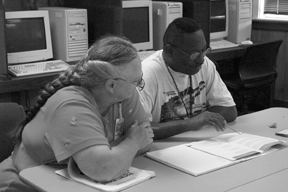 |
| Thelma Morgan, SEP instructor, Roane State Community College, works with Robert Henry of Records, Tranining and SBMS Division and an SEP participant. |
Studies in math, science, technical writing, English as a second language, computer software usage, Web design, HTML, Dreamweaver and FrontPage are among the courses offered in levels ranging from basic to advanced. In addition, enrollees are provided assistance in preparing for the GED exam, pre-college (AAPP) exam, or graduate school entrance exams (GMAT and GRE).
Courses of study are delivered in 15- or 30-hour modules. Participants have 12 months from the date of enrollment to complete their studies. With management approval, the partnership program between ORNL’s management and employees allows participants to spend a maximum of two hours per week, during work hours (on-shift), while volunteering to spend an equal amount of personal time (off-shift) devoted to studies.
ORNL’s SEP coordinator and Roane State’s instructors work with participants and their supervisors to establish attendance schedules that are flexible and accommodating for different shifts and work loads. In addition, to maximize time spent completing module hours, content-based courses, like math, are customized to the individual’s education level, which ensures that each participant starts his/her course of study at the appropriate level without wasting time covering information that is already known.
According to Geogg Deichert, shift technical advisor in the Research Reactors Division and recent enrollee, “Simply taking the assessment has helped me identify classes I need to take to prepare for the MBA program.”
Module costs are charged to the employee’s department or may be charged to a specific account upon request. After completing a course of study, participants can apply for continuing education units through RSCC.
If the SEP sounds like it might be of interest to you, what do you do? The first step is to visit the SEP website at home.ornl.gov/divisions/human_resources/eod/skills.htm, where you’ll find course listings and enrollment forms. If you do not find a study area which meets your needs, contact the ORNL SEP coordinator, Bonnie Brummitt, at 574-4446 or brummittbw@ornl.gov.
 YWCA tribute finalists include Lab staff
YWCA tribute finalists include Lab staff
Three ORNL staff members —Michelle Buchanan, director of Chemical Sciences Division; Kaye Johnson, group leader in Communications and Community Outreach Directorate; and Bernadette Kirk of the Nuclear Science and Technology Division —are finalists in the 2003 Knoxville YWCA’s Tribute to Women.
The annual Tribute to Women honors individuals of high achievement in Knoxville and the surrounding area in seven categories: arts, business and government, education, human services, science and technology, volunteer community service and teen leadership. The recognition signifies leadership, professional growth and significant contributions and impact in the Knoxville area.
Since 1990, 14 category winners and 30 other finalists were from ORNL.
ORNL’s Committee for Women coordinates the selection of the top five nominations to send forward to the YWCA. This year the award jury was chaired by Carol Wood of Life Sciences Division.
Category winners will be named from among the finalists at an awards ceremony on October 23.
ORNL office: P.O. Box 2008, Oak Ridge, TN 37831-6146, Building 4500-S, Room F-60, MS 6146
DOE inspector general hotline: 1-800-541-1625
[an error occurred while processing this directive]
[an error occurred while processing this directive]
Marty Goolsby, lead editor, ORNL, 865/574-4166 (goolsbymb@ornl.gov)
Deborah Barnes, associate editor, 865/576-0470 (barnesds@ornl.gov)

